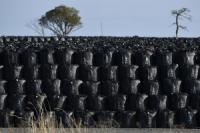-
Helping explosive detection canine teams across the U.S.
Dogs are uniquely suited to sniffing out explosives – their sense of smell is more than a million times stronger than a human’s. Harnessing this natural ability to help law enforcement identify explosives requires specialized training and testing. Many detection canine teams, however, have limited access to critical training materials and limited time to establish rigorous training scenarios. DHS S&T’s Detection Canine Program has developed an initiative to support these needs for the nation’s more than 4,000 explosives detection canine teams.
-
-
No funds for California's earthquake early-warning system in Trump's proposed budget
The Trump administration’s proposed budget would eliminate federal funding for an earthquake early warning system being developed for the U.S. West Coast. Critics say that if the relevant clauses in the budget proposal become law, the long-planned seismic warning effort will be killed. Scientists say the withdrawal of federal funds would likely end the early-warning project, which aims to send smartphone tremor alert messages to West Coast residents.
-
-
Israel to install earthquake early-warning system
Israel has selected Ottawa, Canada-based Nanometrics to build an earthquake early-warning system in Israel. The alert system will give a 10-to-30-second alert of an impending earthquake. The system’s success depends on the distinction between two types of waves an earthquake generates — P waves (for primary) and S waves (for secondary). P waves are very fast, traveling through rock at between four and seven kilometers per second, and are thus the first waves to arrive at a recording station following an earthquake. An S-wave has a shearing motion that makes the rock vibrate perpendicular to its path. This movement slows the S-wave, so that it travels at two to five kilometers per second, or about half the speed of the P-wave. It is S waves which are almost entirely responsible for the damage and destruction associated with earthquakes.
-
-
$2-million grant for training next generation of nuclear arms control experts
Post-Cold War arsenal reductions by the United States and Russia have slowed, and both sides continue to keep many hundreds of weapons on hair trigger alert ready to launch within minutes of a country’s leader pushing the button. Meanwhile, concerns grow about nuclear programs in North Korea, South Asia, and the Middle East. Princeton University’s Program on Science and Global Security (SGS) has received a $2-million grant from the MacArthur Foundation. The award will support SGS’ efforts to educate and train the next generation of researchers and scientists studying nuclear non-proliferation, arms control and disarmament.
-
-
Argonne’s nuclear security training team has a global reach
At Argonne National Laboratory, a team of experts is training foreign scientists and engineers in the peaceful uses of nuclear energy and technology. Although the building is more than 4700 miles from the headquarters of the International Atomic Energy Agency (IAEA) in Vienna, the team is helping it uphold decades of international nuclear cooperation. Over the years, Argonne has taught more than 220 courses to more than 5,000 students, many of whom became leaders of nuclear safety and security abroad.
-
-
U.S. nuclear watchdog greatly underestimates potential for nuclear disaster

The U.S. Nuclear Regulatory Commission (NRC) relied on faulty analysis to justify its refusal to adopt a critical measure for protecting Americans from the occurrence of a catastrophic nuclear-waste fire at any one of dozens of reactor sites around the country, a new study shows. Fallout from such a fire could be considerably larger than the radioactive emissions from the 2011 Fukushima accident in Japan. These catastrophic consequences, which could be triggered by a large earthquake or a terrorist attack, could be largely avoided by regulatory measures that the NRC refuses to implement.
-
-
Mobile phones can reveal exposure to radiation
In accidents or terror attacks which are suspected to involve radioactive substances, it can be difficult to determine whether people nearby have been exposed to radiation. But by analyzing mobile phones and other objects which come in close contact with the body, it is possible to retrieve important information on radiation exposure.
-
-
Bomb squads to compete in annual Robot Rodeo
Robots are life-saving tools for bomb squads and emergency response teams, providing them a buffer from danger. Sandia National Laboratories is hosting the 11th annual Western National Robot Rodeo, a four-day event where civilian and military bomb squad teams get practice using robots to defuse diverse, dangerous situations.
-
-
Pocket-size biological solution to radioactive threats
Yaky Yanay, co-CEO of Pluristem Therapeutics, last week surprised the participants The Jerusalem Post Annual Conference in New York by saying that a small glass vial he pulled out of his pocket offered a solution to Iran’s nuclear threats. “I have the solution in my pocket.” The company has developed an anti-radiation therapy that can be stockpiled for emergencies. The therapy harnesses the power of the human placenta to contain the cascading effect of radiation exposure in the body and allow for the natural healing of cells.
-
-
New plutonium discovery to help nuclear waste clean-up
Plutonium has long been part of many countries’ nuclear energy strategies, but scientists are still unlocking the mysteries behind this complicated element and seeing how they can use heavier, nuclear elements to clean up nuclear waste. Now, new research shows that plutonium does not exactly work the way scientists thought it did. The findings will contribute to the effort to develop technologies to clean up nuclear waste.
-
-
Nuclear storage tunnel collapses at Washington State’s Hanford site; employees evacuated
Hundreds of workers have been forced to “take cover” after a tunnel in a nuclear finishing plant collapsed at the Hanford Nuclear Reservation in southeastern Washington state. The Department of Energy activated its Emergency Operations Center following the collapse. Nuclear experts have criticized to storage and safety practices at the site, calling it “the most toxic place in America” and saying it was “an underground Chernobyl waiting to happen.”
-
-
Quickly detecting structural problems in bridges, dams
Today, there is great interest in using distributed sensors to continually monitor the structural health of large structures such as dams or bridges. With one million sensing points, a newly developed fiber optic distributed sensor could offer significantly faster detection of structural problems than is currently available.
-
-
New evidence shows pattern of Assad regime’s use of nerve agents
New evidence supports the conclusion that Syrian government forces have used nerve agents on at least four occasions in recent months: on 4 April 2017, in a chemical attack on Khan Sheikhoun that killed at least ninety-two people, and on three other occasions in December 2016 and March 2017, Human Rights Watch said in a report released yesterday. These attacks are part of a broader pattern of Syrian government forces’ use of chemical weapons. The attacks are widespread and systematic, and in some cases have been directed against the civilian population. As part of the evidence showing these attacks have become widespread and systematic, the detailed 48-page report identifies the three different systems being used by the Assad regime to deliver chemical weapons.
-
-
New nuclear forensics signature discovery capability to help trace origins of plutonium
Two weeks ago the Department of Homeland Security’s Domestic Nuclear Detection Office (DNDO) joined with partners at the Pacific Northwest National Laboratory (PNNL) to launch the Plutonium Processing Signatures Discovery capability. The new capability, the result of a four-year effort, represents a significant technological advancement in nuclear forensics that will improve our ability to trace the origins of plutonium. Nuclear forensics involves determining where illicit or smuggled radioactive material came from. In the event of a nuclear weapon detonation, knowing where radioactive material came from can help investigators determine who’s responsible.
-
-
France: We have proof Assad ordered chemical attack on Khan Sheikhun

Jean-Marc Ayrault, France’s foreign minister, said Wednesday that France’s intelligence services have evidence that the Syrian government carried out the chemical weapons attack on a Sunni village earlier this month. The Syrian military’s attack on Khan Sheikhun killed eighty-six. British and Turkish scientists, examining injured victims and performing autopsies on those killed, found evidence of both sarin - a nerve gas - and chlorine.
-
More headlines
The long view
Keeping the Lights on with Nuclear Waste: Radiochemistry Transforms Nuclear Waste into Strategic Materials
By John Domol
How UNLV radiochemistry is pioneering the future of energy in the Southwest by salvaging strategic materials from nuclear dumps –and making it safe.
Model Predicts Long-Term Effects of Nuclear Waste on Underground Disposal Systems
By Zach Winn
The simulations matched results from an underground lab experiment in Switzerland, suggesting modeling could be used to validate the safety of nuclear disposal sites.
